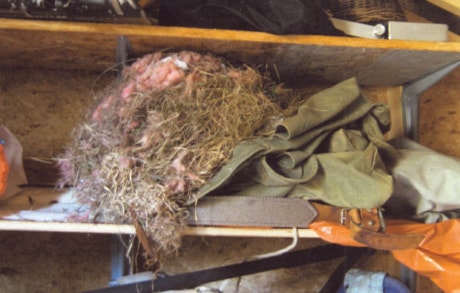“Alberta may be the squirreliest place in North America. From alpine meadows to treeless grasslands, and in forested regions province-wide, squirrels always seem to be only a glance away.” So say Pattie & Fisher in their 1999 field guide, Mammals of Alberta.
Maybe, but the whole wide internet world has gone squirrelly over the upstaging rodent that jumped into the sharp-focus foreground of a self-timer snapshot of a fuzzy couple and Lake Minnewanka in the background. Since then, debate does go on in the letters column of The Calgary Herald as to which species of Alberta’s many squirrels this one is: the consensus being it is a Columbian ground squirrel, although Richardson’s ground squirrel, even the golden-mantled ground squirrel, have their champions.
What the Minnewanka varmint clearly was not was either our native red squirrel or the eastern grey squirrel (mostly black in Alberta) that some nut imported to Calgary, as if we did not already have enough squirrel species in Alberta.
The Eastern rrey is an acorn addict and I remember seeing them foraging an oak grove near the then EID and County offices when I was a kid in Brooks.
Whenever people in Red Deer can stop talking about the ant infestation of this and the past two or three summers, many will start in about red squirrels everywhere, particularly their attics.
Out West, where ants could be of immense use to the trout and fly fishermen, there seems to be an unusually low ant population, but this year’s bumper crop of young red squirrels is starting their annual late summer campaign to drive me squirrelly at the Stump Ranch.
Last weekend one of them scolded and pelted me with spruce cones as I sat reading the paper on my own deck, and any day now I expect to see a nest or two built of grasses and pink fiberglass insulation in the shed: time to stock up on a Resident Trapper’s Licence, rat traps and peanut butter for bait.
A recent incident in Red Deer has shed light on the dark and untold story of the steps Alberta municipalities routinely take to protect trees in parks and recreational areas and to keep roads from flooding owing to the industry of North America’s largest and our national rodent, Castor canadenses, the American Beaver.
A woman running her large dog at about 10 p.m. (after hours) in the off-leash area of Three Mile Bend of the Red Deer River, part of the city’s park and trail system, allowed the dog to go for a drink at a pond, but it ran off into the bush and did not return. She could hear whimpering and found the dog with a snare around its neck, which tightened the more she tried to loosen it.
Eventually a gent turned up who said he was a licensed trapper retained by the city. He released the dog. An overpopulation of beavers is quickly clear-cutting the area of its larger trees. The city has long employed specialists to control beavers. They work only under cover of darkness, which is when the rodents are most active, and that is one of the reasons why many city park areas along the river are closed after dusk.
But some humans are hyper active after dark.
I have known two of Red Deer’s trappers over the years, and both could curl your hair or titillate your libido with tales of the human activities they have heard and seen as they sat quietly in the dark minding their city business.
Recently two Grizzlies killed two prized and expensive miniature donkeys near Sundre. This was just after we heard moans and wails from the few griz lovers among us about an Environment Canada report conceding that the great carnivores will now never be restored to their former prairie ranges in Canada.
Brian Horejsi, Calgary-based independent wildlife scientist, bear advocate and activist, may just have gone a tad over-bearish in an interview he gave for a recent article in The Lethbridge Herald in essence asserting the grizzly could be restored to the prairies if only the federal government would “lean hard constitutionally and legally” on Alberta for having driven the grizzly “virtually to the brink of extinction.”
“If it means,” the Herald quotes Horejsi as saying, “that we have to take this (Provincial land transferred by Canada to Alberta in the Resources Transfer Act of 1930) back from these fools, then we have to do it.” Now, now; the war over that grab would make the response of Alberta to the hated National Energy Policy look like a playground tiff.
Meanwhile, folks in the Sundre area contend the Grizzly is already steadily moving east. Predictably, Calgary newspaper letter writers contend people in the Sundre area deserve their griz problems for having occupied former bear habitat, conveniently ignoring that Calgary itself clutters far too many square miles of the home where the Grizzly once did roam.
Indeed, Alberta may well be the squirreliest place in North America.
Bob Scammell is an award-winning outdoors writer living in Red Deer. He can be contacted at bscam@telusplanet.net
